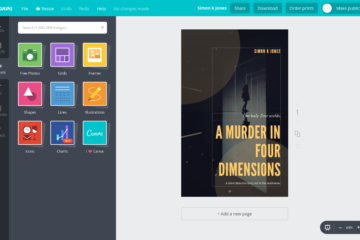I wasn’t planning on writing this for a while. It was on my Trello list of ‘articles to write at some point’ but it got bumped up this evening after I encountered a frantic writer on Facebook who had just lost three months of work and had no backup. Ouch. I don’t want anybody to suffer the crippling anxiety of losing work, so here we are.
(via the helpful people in the SPF Community the guy in question managed to recover the files. Good job, internet)
Backing up is easy and cheap these days, so there’s absolutely no reason not to have a rock solid setup.
First, though, a small note directed at those of you who don’t yet backup any of your work and are wondering whether to bother reading the rest of this article:
THIS IS THE MOST IMPORTANT THING YOU WILL DO TODAY.
READ THIS POST, THEN GIVE YOURSELF 24 HOURS TO GET BACKED UP.
A simple fact of life is that hard drives fail. Doesn’t matter what type of hard drive or how old it is: sometimes they just go pop. When that happens, anything and everything on that drive is gone. There might be a slim chance of recovering it using some serious intervention but it’s going to cost you and might not even work.
Cheaper and easier is to backup in the first place, so that you never have to worry about it even if something does go wrong.
Step 1: Use cloud storage
Cloud technology has matured to a point where it’s extremely easy to use and very reliable. Cloud storage, as provided by the likes of Dropbox, Google Drive and Microsoft OneDrive, provides a way of synchronising part of your computer with remote storage on the internet.
The way it works is that when you update or add a file on your local computer, it instantaneously uploads to the cloud. Let’s say you’ve had an especially productive day of writing, generating 4,000 words of your manuscript plus a whole load of edits. The moment you hit ‘save’, that file goes into your cloud account and you’re backed up. It’s all automated, easy to set up, and you generally don’t have to even think about it.
If your computer has a total meltdown, or even if your house explodes, you can simply re-download all of your stuff from the cloud once you’re up and running again. it’s the perfect off-site backup, which is something that was very hard for individuals to do until this technology came along.
Even when things aren’t going wrong, there are other benefits such as being able to access your core files from any computer or mobile device and have them remain in sync with your main computer, as well as decent versioning so that you can revert back to earlier versions should something weird happen.
Incidentally, don’t worry about copyright and ownership of the files you upload to these systems. By all means give the T&Cs a full read, but these companies don’t claim ownership over any of your data (at least, Google don’t, who I currently use).
Cost: £15.99 for 1 year’s subscription and complete peace of mind.
Step 2: Get a backup external hard drive
Using a cloud setup for your backup is a great way to go but it’s never sensible to have only a single point of backup. Even with a cloud setup you could theoretically run into problems – if you lose access to the internet then you won’t be able to access the cloud, for example. And there’s always a slim chance that something could go awry with the automatic syncing (in half a decade of using Dropbox and Google Drive I’ve only had a couple of incidents, both of which turned out fine). It’s massively unlikely that any of these providers are going to go bust and vanish along with your data, but it’s still something to factor in as a possibility.
That’s why you should invest in a simple external hard drive. You can then plug it into your computer and manually copy files across so that you have another backup. This is the old fashioned way and its low-tech nature is actually part of why it’s worth doing: while automated sync software is available, because you’re handling the transfer directly you’ll know precisely what is going on and won’t need to trust or understand complex automated services.
As long as you’re using the cloud to backup everything moment-to-moment, it’s up to you how often you backup to a physical drive. This will depend largely on how quickly you work – you might want to do it daily, or weekly, or even monthly. Pick a frequency which means that it doesn’t become a burden and also doesn’t risk any major gaps in the data.
A USB memory stick will be plenty big enough for storing simple text documents but I tend to prefer actual hard drives simply because you get more storage space for your money. I also have a habit of carrying memory sticks around with me in pockets and then promptly losing them – but that might just be me.
Cost: £49.99 for a 1TB external Seagate drive from Amazon, or about £20 for a 64GB Sandisk USB memory stick
Bonus Step 3: Publish your work
This might not be an option for you, depending on the type of writing you do and your preferred method of publishing, but one of the benefits I’ve found since switching to a weekly, serialised form of writing and publishing is that I rarely sit on work for long. I don’t keep it under lock and key, instead preferring to let it out into the world.
This means that I effectively have a third public backup. If all else fails, I would be able to retrieve my first novel from my Wattpad account, which is where I’ve been publishing for about three years now.
Cost: Free
Other options
An old school method is to periodically email your document to yourself, or to a trusted friend or partner. That way you have an instant duplicate that can be retrieved in the event of a problem. I don’t go in for this myself these days because it can lead to something of a versioning nightmare. It’s also impractical if you work on anything other than tiny Word documents. Really, this method has been replaced by the cloud options.
Even more medieval is actually printing out a physical version of the manuscript, so that you have a hard copy. It’s not a bad plan, especially once you’ve completed a draft, in that it provides an entirely analogue form of backup, which could be useful in the event of a global energy crisis or digital blackout. But if that happens we’ll probably all have other things to be worrying about anyway.
Hopefully you’re already doing at least one of the above. If you’re not, and you’re wondering whether it’s really worth the bother, just consider this: how much do you value your own writing? If you don’t feel it’s worth protecting, then readers may well not think it’s worth reading. I doubt that’s the case, so make backing up as essential to your life as putting words onto a page.


4 Comments
Gretchen · May 10, 2018 at 2:08 pm
Thank you for this, it’s time I got sensible. So this is a silly question but as a bigtime user of google drive how do I get regular files from my windows system to automatically be backed up there, as in, option 1 above? I’ve practically stopped using my computer hard drive in recent years but formatting limitations in Gdrive send me back to word quite often lately as I have a more complex bit of work to create (thesis!). So I’d like to back my word docs up to drive without thinking about it. Is there a magic trick to that? Many thanks (and I got here when looking at how to back scrivener up to Drive as I also flit between PC and my faithful chromebook… right, going to read that now)
Simon Jones · May 11, 2018 at 8:01 pm
Hi Gretchen! You can download a Drive app from Google which you can install onto your Windows computer. It creates a special folder on your hard drive which is a mirror of your Google Drive. Anything you put in that folder will automatically sync up to your Drive cloud. I do most of my work on my computer in my Google Drive, so that everything is automatically backed up remotely without me even having to think about it. I still do manual local backups occasionally as well, of course, just in case the internet explodes Blade Runner 2049-style. This is also the method I use to sync Scrivener between my Windows computer and my Chromebook.
The app is called ‘backup and sync’ and you should be able to find it by clicking the settings gear icon near the top-right of Drive’s web interface.
norro211 · October 7, 2018 at 9:15 am
There are some gotchas. Some cloud backup sync with your local files and only store old versions for 30-60 days so unless you spot a missing file promptly you can lose data. HDs are good for ongoing copies but are vulnerable to disk failures (especially if you move them on/offsite a lot) but also degradation over time. They may be corrupted after 5 years or so if files aren’t refreshed. Another option for archival backups are Bluray discs which can last hundreds of years which is much longer than a writable CD or DVD.